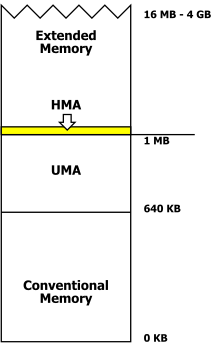This article includes a list of references, related reading, or external links, but its sources remain unclear because it lacks inline citations. (June 2016) |

In DOS memory management, extended memory refers to memory above the first megabyte (220 bytes) of address space in an IBM PC or compatible with an 80286 or later processor. The term is mainly used under the DOS and Windows operating systems. DOS programs, running in real mode or virtual x86 mode, cannot directly access this memory, but are able to do so through an application programming interface (API) called the Extended Memory Specification (XMS). This API is implemented by a driver (such as HIMEM.SYS) or the operating system kernel, which takes care of memory management and copying memory between conventional and extended memory, by temporarily switching the processor into protected mode. In this context, the term "extended memory" may refer to either the whole of the extended memory or only the portion available through this API.
Extended memory can also be accessed directly by DOS programs running in protected mode using VCPI or DPMI, two (different and incompatible) methods of using protected mode under DOS.
Extended memory should not be confused with expanded memory (EMS), an earlier method for expanding the IBM PC's memory capacity beyond 640 kB (655,360 bytes) using an expansion card with bank switched memory modules. Because of the available support for expanded memory in popular applications, device drivers were developed that emulated expanded memory using extended memory. Later two additional methods were developed allowing direct access to small portions of additional memory above 640 KB from real mode. One of these is referred to as the high memory area (HMA), consisting of the first nearly 64 KB of extended memory, and the other is referred to as the upper memory area (UMA; also referred to as upper memory blocks or UMBs), located in the address range between 640 KB and 1 MB which the IBM PC designates for hardware adapters and ROM.